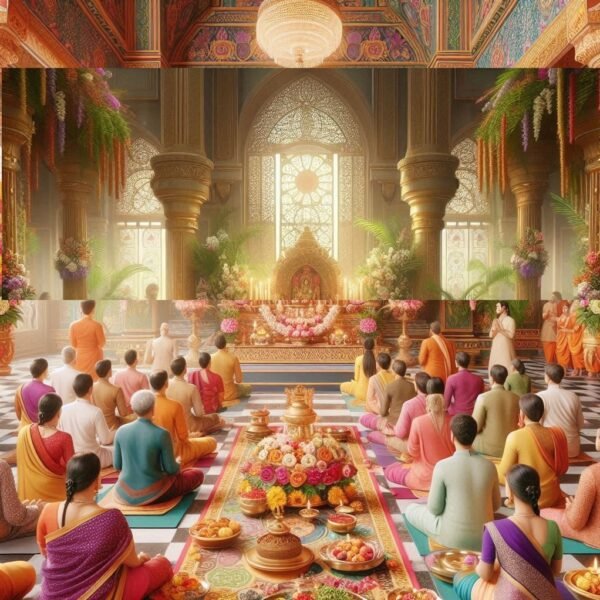Sarva Dosha Nivarana Puja

Sarva Dosha Nivarana Pooja is a Hindu ritual aimed at neutralizing negative influences, often called “doshas,” which can stem from astrological, planetary, or spiritual imbalances. The term “Sarva Dosha” translates to “all afflictions,” and “Nivarana” means removal or remedy, so the pooja seeks to eliminate various obstacles, curses, or negative energies affecting an individual’s health, prosperity, or success.
Purpose:
Addresses astrological doshas like planetary malefic effects (e.g., Saturn’s transit), Pitru Dosha (ancestral curses), or other spiritual imbalances.
Aims to bring peace, prosperity, and success by removing negativity and restoring balance.
Can target specific issues like health, career, or family problems.
Common Practices:
Deity Invocation: Typically involves invoking deities like Lord Ganesha, Goddess Durga, or Lord Shiva for blessings.
Rituals: May include homam/havan (fire rituals), abhishekam (sacred bathing of deities), or offerings like coconut breaking to shatter negativity.
In some traditions, it involves worshipping a married woman (Sumangali) as a manifestation of Goddess Durga.
Specific rituals like Narayana Bali Pooja may be performed for ancestral doshas or premature deaths in the family.
Locations:
Often performed at significant temples like Tiruvarur Thyagaraja Swamy Shiva Temple in Tamil Nadu, known for addressing all types of doshas.
Other locations include Vaitheeswaran Koil or Gokarna for specific dosha-related rituals.
Variations:
Sarva Rog Nivaran Puja: Focuses on health, aiming to alleviate physical and mental ailments.
Sarva Kasht Nivaran Puja: Targets specific problems in health, business, or family.
Sarva Karya Siddhi Puja: Performed for success in endeavors like business or profession.
Nav Grah Puja: Focuses on planetary doshas to mitigate negative astrological effects.
Sarva Dosha Nivarana Puja
Sarva Dosha Nivarana Puja is a traditional Hindu ritual performed to remove or reduce the effects of all types of doshas (negative influences or afflictions) that may be present in a person’s life or horoscope. These doshas can arise due to planetary positions, karmic reasons, ancestral issues, or other spiritual factors, and are believed to cause obstacles in health, relationships, career, and overall well-being.
Purpose and Significance
The puja is designed to address and neutralize all kinds of doshas, including those related to planets (Navagraha doshas), ancestors (Pitru dosha), serpent afflictions (Naga/Sarpa dosha), and more.
It is commonly performed to bring peace, prosperity, health, and success by removing persistent problems and negative energies.
Deities and Rituals Involved
The main deities invoked during this puja are Lord Shiva, Lord Vishnu, and the Navagrahas (nine planets).
The ritual includes chanting of Vedic mantras, performing a homam (fire ritual), and offering prayers and oblations for forgiveness and blessings.
Typical Procedure
Sankalpa: The priest states the devotee’s intention for the puja.
Invocation: Deities are invoked through prayers and mantras.
Homam/Havan: Offerings are made into a sacred fire while chanting powerful mantras.
Dosha Removal Prayers: Special rituals are performed to address and neutralize specific doshas.
Prasad Distribution: Blessed offerings are given to the devotees at the end.
Benefits
Removes obstacles and negative influences from life.
Provides relief from health issues, delays in marriage, career setbacks, and other persistent problems.
Brings peace, prosperity, and fulfillment of desires.
Offers protection from evil forces and negative energies.
Special Notes
The puja can be customized based on the individual’s horoscope and specific doshas.
It is best performed under the guidance of experienced priests following traditional Vedic procedures.
Some people choose to perform this puja periodically or on auspicious days for maximum benefit.
Associated Rituals
Related rituals include Sarpa Dosha Nivarana Puja, Navagraha Shanti, and Maha Sudarshana Homam, each targeting specific types of doshas or negative energies.
| Aspect | Details |
|---|---|
| Purpose | Removal of all doshas and negative influences |
| Main Deities | Lord Shiva, Lord Vishnu, Navagrahas |
| Key Rituals | Sankalpa, invocation, homam/havan, mantra chanting, prasad distribution |
| Benefits | Obstacle removal, health, prosperity, peace, fulfillment of desires |
| Customization | Based on individual horoscope and doshas |
Sarva Dosha Nivarana Puja
Sarva Dosha Nivarana Puja is a powerful Hindu ritual performed to remove or neutralize all types of doshas (malefic influences or karmic afflictions) in one’s horoscope or life. “Sarva” means all, “Dosha” means flaws or defects, and “Nivarana” means removal. This puja is aimed at alleviating obstacles that may arise due to planetary positions, past karma, ancestral issues, or spiritual disturbances.
Purpose of Sarva Dosha Nivarana Puja
This puja is commonly performed to mitigate the effects of:
-
Graha Dosha (planetary afflictions, such as Rahu-Ketu, Shani, Mangal)
-
Pitru Dosha (ancestral curses or unresolved ancestral karma)
-
Naga Dosha (related to serpent curses or issues from past births)
-
Kala Sarpa Dosha (all planets between Rahu and Ketu)
-
Drishti Dosha (evil eye or negative energy)
-
Black magic or spiritual disturbances
Benefits
-
Relief from chronic problems or recurring failures.
-
Improved health, relationships, and finances.
-
Peace of mind and protection from negative energies.
-
Smoother marriage prospects or family harmony.
-
Positive planetary alignment for career and success.
Where It’s Performed
Typically performed at powerful temples or religious places like:
-
Kalahasti (Andhra Pradesh) – known for Kala Sarpa Dosha remedies.
-
Trimbakeshwar (Maharashtra) – famous for Pitru Dosha puja.
-
Rameshwaram (Tamil Nadu) – often part of dosha nivarana rituals.
-
Can also be done at local temples or homes under priest guidance.
Procedure (Common Elements)
-
Sankalpam – taking a vow with your name, gotra, and intent.
-
Ganapati Puja – invocation of Lord Ganesha to remove obstacles.
-
Navagraha Puja – worship of the nine planets.
-
Specific Dosha Puja – rituals tailored to your dosha(s).
-
Homa (Havan) – fire ritual to appease planets and remove karmic baggage.
-
Tarpanam – offerings to ancestors (especially for Pitru Dosha).
-
Purnahuti and Aarti – conclusion and blessings.
Best Days to Perform
-
Amavasya (New Moon) – especially for Pitru-related doshas.
-
Eclipse days – for Rahu-Ketu-related afflictions.
-
Saturdays – for Shani Dosha.
-
During planetary transits or your birth star (Nakshatra) day.
Preparation Tips
-
Consult a Vedic astrologer to identify the specific doshas.
-
Follow fasting or purification rituals before the puja.
-
Wear clean or traditional clothes; maintain a pure mindset.
-
Offer Dakshina (donation) and food to Brahmins or the poor after the puja.
Sarva Dosha Nivarana Puja
“Sarva Dosha Nivarana Puja” is a comprehensive Hindu ritual performed to alleviate and neutralize various “doshas” or negative influences and afflictions in one’s life, as per Vedic astrology. The term “Sarva” means “all,” “Dosha” refers to flaws or negative planetary configurations in a birth chart, and “Nivarana” means “alleviation” or “remedy.”
Understanding Doshas:
In Vedic astrology, doshas are believed to arise from the malefic placement or influence of planets in an individual’s horoscope (Kundali). These doshas can lead to various challenges, including:
- Health problems: Chronic ailments, unexplained illnesses.
- Mental unrest: Stress, anxiety, depression, unnecessary fears.
- Relationship issues: Marital discords, delays in marriage, family disputes.
- Career and financial obstacles: Delays in success, business losses, financial instability.
- Lack of overall prosperity and peace.
Common doshas include:
- Navagraha Doshas: Negative influences from any of the nine planets (Sun, Moon, Mars, Mercury, Jupiter, Venus, Saturn, Rahu, Ketu).
- Kaal Sarp Dosha: Formed when all seven planets are positioned between Rahu and Ketu.
- Pitra Dosha: Related to ancestral debts or issues.
- Mangal Dosha: Caused by the malefic placement of Mars, often associated with marital difficulties.
- Guru Chandal Dosha: A combination of Jupiter and Rahu/Ketu.
- Vastu Dosha: Related to architectural flaws in a living or working space.
Significance and Benefits of Sarva Dosha Nivarana Puja:
The primary aim of this puja is to pacify the malefic planetary influences and negative energies, thereby bringing positive changes and harmony into the devotee’s life. The benefits often include:
- Removal of negative effects of planets: It aims to reduce the harmful impact of all nine planets, promoting auspicious energies.
- Elimination of specific Kundali doshas: It targets and neutralizes doshas like Pitru dosha, Manglik dosha, Rahu dosha, and Shani dosha.
- Relief from health issues: It is believed to help overcome chronic ailments, boost immunity, and provide protection from diseases and accidents.
- Mental and emotional well-being: It can alleviate stress, anxiety, and fears, leading to greater inner strength, peace, and fortitude.
- Success, prosperity, and wealth: It is performed to remove obstacles in career and business, attracting wealth and overall prosperity.
- Harmony in relationships: It can help resolve marital and family disputes.
- Protection: It creates a protective shield against various dangers, evil eye, and unforeseen circumstances.
Procedure of Sarva Dosha Nivarana Puja:
While the specific details can vary depending on the tradition and the particular doshas being addressed, a general procedure often involves:
- Auspicious Date and Time (Muhurat) Selection: An astrologer or priest typically determines a suitable time based on the individual’s birth chart and the planetary positions.
- Preparation: This includes setting up a clean and sacred puja area, ideally facing east, and gathering essential puja materials (incense, flowers, fruits, ghee, rice, turmeric, vermilion, holy water, etc.).
- Invocation of Deities and Planets:
- Lord Ganesha is typically invoked first to remove obstacles.
- The Navagrahas (nine planets) are individually called upon and honored with specific mantras.
- Deities associated with specific doshas (e.g., Lord Shiva for Maha Mrityunjay, Goddess Durga for removing negative powers, Lord Hanuman for strength) are also invoked.
- Havan/Homam (Fire Ritual): A sacred fire (Havan Kund) is established as the focal point. Mantras dedicated to the Navagrahas and other deities are chanted, and offerings (like sacred wood, ghee, grains) are made into the fire.
- Mantra Chanting: Specific mantras related to the planets and deities are chanted repeatedly to generate positive vibrations.
- Purnahuti: A final offering is made into the fire, signifying the completion of the homam.
- Aarti: Waving of lamps in front of the deities.
- Distribution of Prasad: Offerings blessed during the puja are distributed to participants.
- Further Guidance: Consulting with a priest or astrologer after the puja for continued guidance is often recommended.
Cost of Sarva Dosha Nivarana Puja:
The cost of the Sarva Dosha Nivarana Puja can vary significantly based on:
- Complexity of the Puja: Whether it’s a general “Sarva Dosha” puja or a highly customized one targeting specific severe doshas.
- Number of priests: More priests mean a higher cost.
- Duration of the puja: A longer or more elaborate puja will naturally cost more.
- Materials used: The quality and quantity of offerings.
- Location: Prices can differ depending on the city, temple, or online service provider.
- Inclusions: Whether the cost includes a yantra, rudraksha, or prasad delivery.
Online puja services often provide various packages, ranging from a few thousand Indian Rupees (INR) to upwards of INR 10,000 or more, depending on the scale and specific requirements. For instance, a basic Navagraha Shanti Mahayagya might start around INR 11,000 (approx. $131 USD), while more comprehensive or customized pujas could be higher. Yantras related to “Sarva Dosha Nivarana” can range from a few hundred to a few thousand INR, depending on the material and size.
It’s advisable to consult with a reputable astrologer or a trusted purohit (priest) to understand the specific doshas in your horoscope and determine the most appropriate puja for your situation.

